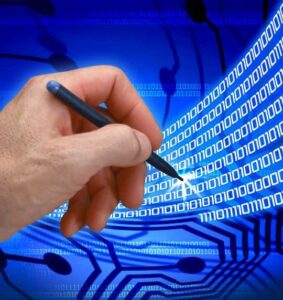The Shift to Electronic Signatures on Contracts
It’s always entertaining to tell younger attorneys about the inefficient ways that lawyers did their jobs back in the day, without modern technology (and probably extremely boring for the younger attorneys to hear those stories). For example, as a junior attorney, I recall that email was just starting to come into common usage, and the job of the paralegal often involved early evening distributions – sending out FedEx distributions of revised drafts of documents before the 9pm overnight delivery cutoff. One aspect of current legal practice that will likely be looked at in the coming years as equally antiquated is the obtaining of manual signatures on contracts.
 This Slate Explainer has a short but informative history of the use of signatures on legal documents. Technology has made the process somewhat more streamlined (fax machine, then PDFs), but signatures remain a practical impediment to quick completion of agreements. In 2016, there are still delays when a party cannot immediately sign an agreement as a result of being, for example, traveling without access to a scanner. Attorneys with good organizational skills know to obtain and hold onto signature pages from a client who is about to travel ahead of a closing, but there is more stress and scrambling than there needs to be.
This Slate Explainer has a short but informative history of the use of signatures on legal documents. Technology has made the process somewhat more streamlined (fax machine, then PDFs), but signatures remain a practical impediment to quick completion of agreements. In 2016, there are still delays when a party cannot immediately sign an agreement as a result of being, for example, traveling without access to a scanner. Attorneys with good organizational skills know to obtain and hold onto signature pages from a client who is about to travel ahead of a closing, but there is more stress and scrambling than there needs to be.
Fortunately, the technology is improving further, as we speak, via electronic signature services like DocuSign. The federal ESIGN Act, enacted in 2000, provided broad recognition of the validity of electronic signatures, which paved the way for these types of services. They allow parties to sign agreements easily via any internet-enabled device, without a scanner or fax machine, so really the only time an agreement can’t be signed is if the signatory is on a plane and doesn’t want to spring for wi-fi or is deep in the wilderness. My clients are increasingly requesting that these services be used, and I expect them to be widely adopted in the coming years. And the coming generation of new corporate attorneys can laugh at the likes of me for having spent time chasing down manual signatures.
The Shift to Electronic Signatures on Contracts Read More »

 Matt Levine writes in Bloomberg View about
Matt Levine writes in Bloomberg View about  Ernest Holtzheimer blogs with
Ernest Holtzheimer blogs with  The Wall Street Journal recently detailed
The Wall Street Journal recently detailed  First, an important caveat. Balestriere is a litigator, and my understanding (not based on experience) is that in that area, small firms and governmental agencies kind of throw young attorneys into handling trial work pretty much right away, as opposed to the large firm experience of having junior associates handle more behind-the-scenes work. I can’t speak to that; my advice in this post applies to those thinking of becoming a transactional attorney.
First, an important caveat. Balestriere is a litigator, and my understanding (not based on experience) is that in that area, small firms and governmental agencies kind of throw young attorneys into handling trial work pretty much right away, as opposed to the large firm experience of having junior associates handle more behind-the-scenes work. I can’t speak to that; my advice in this post applies to those thinking of becoming a transactional attorney. Although it has historically been relatively easy for companies to enforce non-competition agreements against employees in New York State, compared to, say, California, where such provisions are unenforceable,
Although it has historically been relatively easy for companies to enforce non-competition agreements against employees in New York State, compared to, say, California, where such provisions are unenforceable,  Writing his usual daily roundup in Bloomberg View, Matt Levine, a former corporate attorney and investment banker who is perhaps the only person in the world who writes in a laugh-out-loud manner about securities law, raises interesting points on two unrelated topics:
Writing his usual daily roundup in Bloomberg View, Matt Levine, a former corporate attorney and investment banker who is perhaps the only person in the world who writes in a laugh-out-loud manner about securities law, raises interesting points on two unrelated topics:  Personal Service – Many of my clients are referred from colleagues of mine, and the client doesn’t comparison shop with other firms before hiring me, but in situations where I find myself in a competition with another firm, that firm is often a mid-sized or large firm, rather than one with my profile. In that scenario, the appropriate strategy is to play up the differences between my way of doing business versus the large firm way. Accordingly, I emphasize the personal service that I provide. In a big firm (and I speak from much experience there), the pitch meeting will often be led by the senior partner, but after the deal starts, you find yourself dealing mostly with someone more junior. In contrast, I point out to the potential client that I am the sole point of contact, though I have experienced attorneys doing behind-the-scenes work to help me keep up with my workload and be able to be responsive to the requests of multiple clients.
Personal Service – Many of my clients are referred from colleagues of mine, and the client doesn’t comparison shop with other firms before hiring me, but in situations where I find myself in a competition with another firm, that firm is often a mid-sized or large firm, rather than one with my profile. In that scenario, the appropriate strategy is to play up the differences between my way of doing business versus the large firm way. Accordingly, I emphasize the personal service that I provide. In a big firm (and I speak from much experience there), the pitch meeting will often be led by the senior partner, but after the deal starts, you find yourself dealing mostly with someone more junior. In contrast, I point out to the potential client that I am the sole point of contact, though I have experienced attorneys doing behind-the-scenes work to help me keep up with my workload and be able to be responsive to the requests of multiple clients.